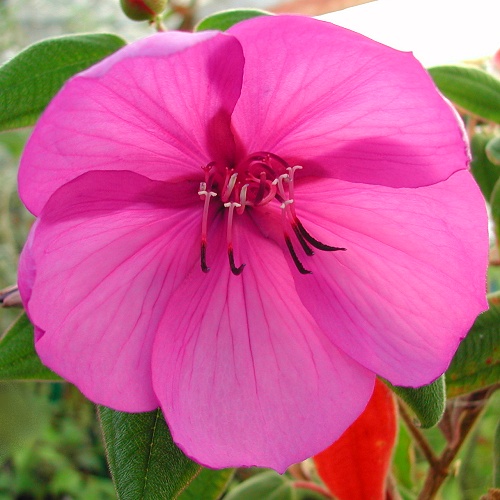Germinating the seeds
Getting started -- Use about 5 to 10 small pots or cups with drainage holes that are 2-4 inches (5-10 cm) tall. Use a well-draining soil. A typical
soil mix for germinating them is 2 parts potting soil to 1 part
perlite The seeds are small, so work in a well-lit area. Sprinkle several seeds evenly across the surface of each pot. An easy way to pick up the seeds is by breathing on your finger tip to lightly moisten it, then dabbing the seeds with it. If you have long-fibered sphagnum moss (not ground peat moss), sprinkle a little over the surface. This helps retain moisture around the seeds while allowing light to reach them, which aids germination. This photo shows how much moss to use. If you don't have sphagnum moss, sprinkle some of your soil mix over the surface. Then add water until everything is evenly moist. Until the seeds sprout, ensure that the soil surface never dries out. A good way to maintain high humidity is by enclosing the pots in a plastic container or bag. Leave it open slightly to let in fresh air. You may need to drip a few drops of water on the surface every few days to keep it moist. They germinate best with cool nights. During the day, try to keep them between 64-76 degrees F (18-24°C), and at night, keep them between 40-64°F (7-18°C). Avoid letting them above 80 degrees F (27°C). I recommend placing a minimum/maximum thermometer near the pots, especially if using a heating mat. Keep them in a bright spot out of direct sun. An LED or fluorescent bulb kept 4 inches (10 cm) away provides the right amount of lighting (See: "Growing indoors with LED lights"). Give at least 12 hours of light. The seeds should start sprouting within about 6 weeks, but may take longer sometimes. Once they sprout, continue dripping water on the soil surface daily the first month, since young seedlings have a small root system. A week after they sprout, open the plastic container or bag slightly more, to allow some more air circulation, to prevent rot. When the seedlings are 4-6 weeks old, gradually lower the humidity around them by opening their container or bag a little more every few days. When they're 2 months old, carefully pull them and transplant them - or simply cut off any slower ones, leaving 1 strong seedling in each pot. Fertilizing -- When they are 5-7 days old, give a small amount of diluted liquid fertilizer (about 1/8 strength), and repeat once a week. Hydroponic fertilizer is ideal for young seedlings, since it is easily absorbed and complete. Once they are 3 months old, you may switch to an ordinary granular fertilizer, feeding about every 2-3 months. Watering -- When they are a month old, you may allow the soil surface to dry between waterings, but keep the rest of the soil evenly moist (but not fully saturated). Lighting -- Give bright, filtered light until the plants are 2-3 inches tall (5-8 cm), then you may slowly acclimate it to direct sun over a period of a few weeks. Shade it from strong afternoon sun. Transplanting -- When they are about 3 inches tall (8 cm), repot to a larger container about 1 quart (1 liter) in size. Repot gently to avoid damaging the root hairs. Protect from direct sun the first week after repotting. Growing onward... Climate -- In the wild, it's found at about 4000-5000 foot elevation, where temperatures are mild all year and nights are cool. It's possible that it won't thrive if temperatures consistently get above the low 80s (28°C) and nights are warm. It might tolerate warmer conditions if nights are cool (below 65°F / 18°C). It probably can survive a light frost, but i strongly recommend protecting it from freezing temperatures. It enjoys sunny conditions in cooler weather, but some afternoon shade might be needed in warmer conditions. Over about 40-45% humidity is best. If it seems to suffer from low humidity indoors, consider using an ultrasonic humidifier. If you have any questions or problems, please contact me. Have fun growing them! - Jeff Strange Wonderful Things
|
|||||||||


